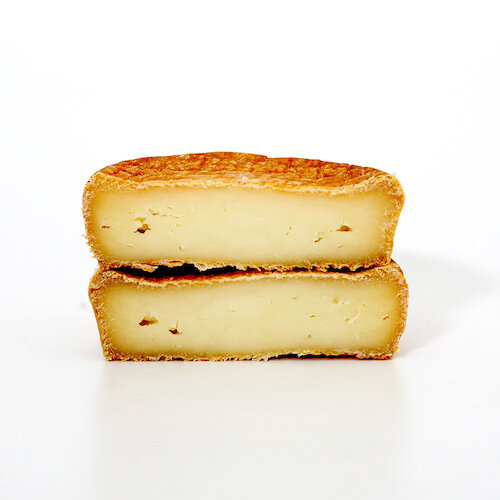A Brief History of Cheesemaking with Thistle Rennet
For reasons ranging from politics to diet, many vegetarians avoid cheese made with animal rennet. But plant-based rennet has been used in cheese production for thousands of years, and although the resulting cheeses may be less consistent their sheer variety makes them well worth seeking out.
Spiny and bulbous with a crowning tuft of violet, the cardoon (Cynara cardunculus) is a hearty thistle belonging to the sunflower family. A perennial plant that thrives in a dry summer climate, wild cardoons have long been present around the sunny Mediterranean. They’ve grown in the basin for so long, in fact, that the use of cardoon thistle in cheesemaking dates back to ancient civilization.
Whether this utility was discovered by way of systematic trial and error or as a happy accident is anyone’s guess, but the thistle’s enduring use in cheese production can almost certainly be credited to the fact that it isn’t an animal. As those in the cheese industry are well aware, animal rennet comes from fluid found in the stomachs of suckling ruminants, where enzymes (chymosin, most notably) aid the digestion process by coagulating milk. The cardoon thistle, meanwhile, contains enzymes (cardosin is the headliner in this case) which function similarly to chymosin to break down the casein proteins in milk. Since harvesting conventional rennet requires the slaughter of young animals, thistle and other plant-derived rennets are valuable both for reasons of access and their versatility in adapting to cultural needs.
History of Thistle Rennet
Columella, who died in 70 AD, wrote about cheesemaking with thistles in Book 7 of his 12-volume work on Roman agriculture, De Re Rustica. While it’s likely that the industrious ancient Romans exported the concept of thistle rennet cheese production around Europe, the technique may have quietly originated in Spain and Portugal.
“The region's mountain and coastal areas were home to fully integrated farming communities,” explains Max Melvin, Senior Cheesemonger at La Fromagerie in London. “The whole of a lamb, for example, would have been eaten — including its stomachs — so there wouldn’t have been traditional rennet available for cheesemaking. Instead, they used some of the local plants to coagulate the milk and turn it into curds to make soft cheeses.”
More specifically, Iberian Jews are widely credited with the development of thistle rennet since Jewish dietary law forbids the mixing of meat with milk, and animal rennet is considered to be a meat product. As described in The Oxford Companion to Cheese (Oxford University Press, 2016), “Jews had arrived in Spain as early as the first century b.c.e., and evidence of thistle-coagulated cheesemaking generally follows their migration patterns as they moved around the peninsula seeking safety and economic self-determination depending on the social pressures of the subsequent centuries.”
Indeed, today’s most recognizable thistle rennet cheeses still come from the Iberian Peninsula. Thistle rennet works best with goat and sheep’s milk, and the resulting cheeses are characteristically soft, with nuanced flavors that are deeply expressive of local terroir.
“The most traditional in Spain and Portugal are these amazing cheeses that you cut the top off of and spoon into the middle, almost like a room-temperature fondue,” says Melvin. He describes a pleasant bitterness reminiscent of white wine acidity, sometimes with notes of beurre blanc, “almost like scallops in a cream sauce.”
Thistle Cheeses
Thistle cheeses are known to be rather inconsistent in flavor, so there’s no guarantee of enjoying the same cheese in the same way twice. This isn’t uncommon with fermented products, when the soil, climate, and grasses on which the animals dine all have an effect on milk flavor before rennet of any variety is added — never mind the rest of the production and aging process. With thistle cheeses, though, aging is brief, and most are less than three months old.
For Melvin, the ever-changing flavors are what makes thistle rennet cheeses so exciting. And he knows enough of what can be expected to have no trouble waxing poetic about the cheeses to curious consumers: “They’re kind of meaty and flowing and moreish; they have a lightness and then an acidity which matches the fattiness, and they often have a strong herbal flavor. They’re lovely.”
Future of Thistle Rennet
While southern Europe remains at the heart of thistle rennet cheese production, there’s a growing interest in this alternative enzyme among cheesemakers in both the United Kingdom and the United States. Aside from thistle rennet’s historical advantages in relation to farming systems and cultural or religious reasons, it’s simply an interesting ingredient to work with. Results can and do vary, but cheesemaking is a perpetual journey of trial and error.
“The new British artisan cheesemakers are in the enviable and unenviable position of not really having any constraints on their creativity,” says Melvin, referring to the vast array of cheese styles a producer may be tempted to try recreating with thistle rennet. “I think sometimes it’s about finding what works with your herd of animals and the milk and the land; and sometimes it’s about having a stab at what the market would be interested in.”
In the US, Christine Clark of Your Cheese Friend and Cheese Professor contributor draws an interesting parallel between thistle rennet and the natural wine movement. “It’s not the mainstream approach and there are some poorly-made versions, but the producers who do it the right way are making something very special.”
Two examples of these producers are Oak Leaf Creamery in Oregon and Lark’s Meadow Farms in Idaho.
Thistle Rennet Cheeses
They’re not always easy to come by and, given their delicate nature, many purveyors shops won’t ship thistle rennet cheeses; but here are a few to keep in mind for future sampling:
Portugal Ewe Azeitao
Azeitão is a sheep’s milk cheese from Portugal. Herbaceous and sweetly earthy in flavor.
Portugal Ewe Evora
Évora is also Portuguese and made with sheep’s milk. Spicy and acidic in flavor and aroma.
Portugal Ewe Serra d’Estrela
Serra d’Estrela, another sheep’s milk Portuguese cheese, is floral and sharp.
Spain Ewe Torta de Dehesa
Torta de Dehesa is a spoonable, sheep’s milk offering from Spain. Silky and acidic with notes of mushroom.
Spain Ewe Torta del Casar
Torta del Casar, also from Spain and made with sheep’s milk, has a creamy, smooth paste with briney notes of baked bread and artichoke.
Britain Goat Sinodun Hill
Sinodun Hill is a goat’s cheese from Britain. Notes of citrus inside, with a slightly nutty rind.







